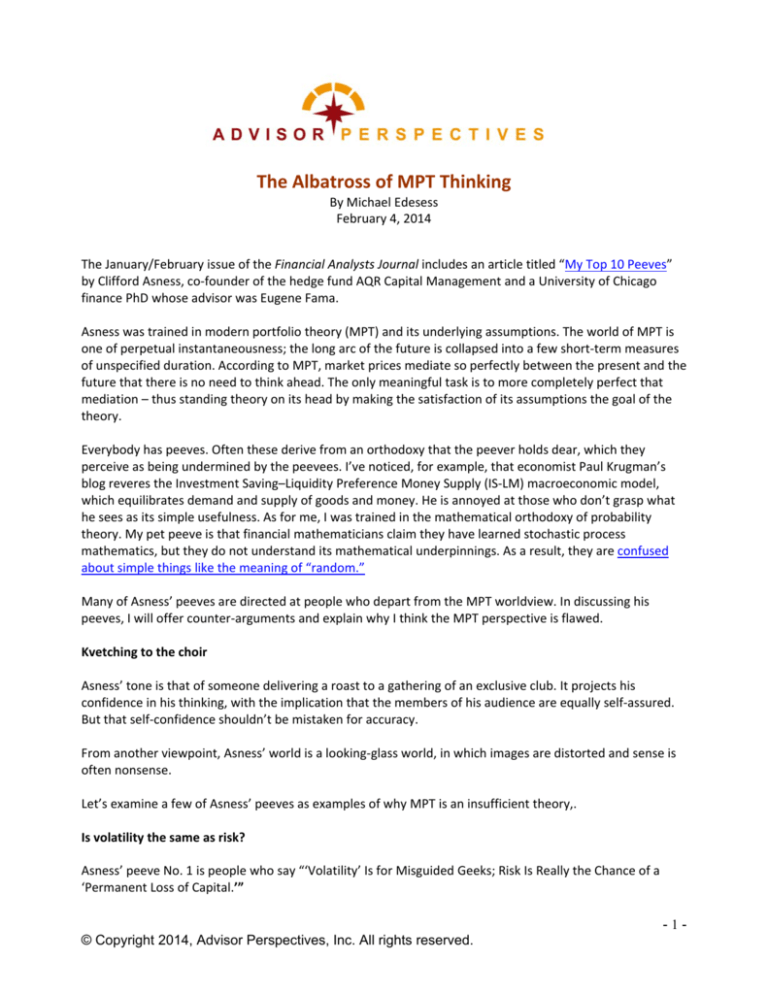
The Albatross of MPT Thinking By Michael Edesess February 4, 2014 The January/February issue of the Financial Analysts Journal includes an article titled “My Top 10 Peeves” by Clifford Asness, co‐founder of the hedge fund AQR Capital Management and a University of Chicago finance PhD whose advisor was Eugene Fama. Asness was trained in modern portfolio theory (MPT) and its underlying assumptions. The world of MPT is one of perpetual instantaneousness; the long arc of the future is collapsed into a few short‐term measures of unspecified duration. According to MPT, market prices mediate so perfectly between the present and the future that there is no need to think ahead. The only meaningful task is to more completely perfect that mediation – thus standing theory on its head by making the satisfaction of its assumptions the goal of the theory. Everybody has peeves. Often these derive from an orthodoxy that the peever holds dear, which they perceive as being undermined by the peevees. I’ve noticed, for example, that economist Paul Krugman’s blog reveres the Investment Saving–Liquidity Preference Money Supply (IS‐LM) macroeconomic model, which equilibrates demand and supply of goods and money. He is annoyed at those who don’t grasp what he sees as its simple usefulness. As for me, I was trained in the mathematical orthodoxy of probability theory. My pet peeve is that financial mathematicians claim they have learned stochastic process mathematics, but they do not understand its mathematical underpinnings. As a result, they are confused about simple things like the meaning of “random.” Many of Asness’ peeves are directed at people who depart from the MPT worldview. In discussing his peeves, I will offer counter‐arguments and explain why I think the MPT perspective is flawed. Kvetching to the choir Asness’ tone is that of someone delivering a roast to a gathering of an exclusive club. It projects his confidence in his thinking, with the implication that the members of his audience are equally self‐assured. But that self‐confidence shouldn’t be mistaken for accuracy. From another viewpoint, Asness’ world is a looking‐glass world, in which images are distorted and sense is often nonsense. Let’s examine a few of Asness’ peeves as examples of why MPT is an insufficient theory,. Is volatility the same as risk? Asness’ peeve No. 1 is people who say “‘Volatility’ Is for Misguided Geeks; Risk Is Really the Chance of a ‘Permanent Loss of Capital.’” -1© Copyright 2014, Advisor Perspectives, Inc. All rights reserved.
I would say something similar: Financial risk is the chance of running out of money, permanently, sometime in the future. But you can eliminate that risk completely without eliminating high volatility. Here is a simple example, though there are more realistic and more complicated variants. Suppose you want, with certainty, to spend $500,000 in 30 years – say, to educate your grandchildren‐to‐
be. At current yields, a Treasury bond strip purchased for $160,000 will do it. There’s no risk of not meeting your specific objective (at least not under the conventional assumption that U.S. Treasury bonds carry no default risk). But if your overriding risk measure is volatility, the risk is the same as that of an equity portfolio. The bond strip’s market price (the price of a zero‐coupon bond with a specific maturity date) will fluctuate as much as that of an equity portfolio, even though there’s no risk of failing to meet your objective. Volatility is an inappropriate measure of risk in this case. I was curious what Asness’ rebuttal would be, but he does not address that objection in his article. Instead, he says, “The critics [of volatility] are usually envisioning an overvalued security (which, of course, they assume they know is overvalued with certainty) that possesses a low volatility. They think quants are naive for calling a security like this ‘low risk’ because it’s likely to fall over time.” I’m afraid I don’t know those critics. But I do know critics of volatility who have the same problem with it that I have. Asness converts a question of long‐term risk (the risk of running out of money sometime in the future) to a question of short‐term – or rather, time‐unspecific – MPT measures like expected return and volatility. If a quant and the quant’s critic (the “non‐quant,” as Asness says, seemingly implying that quant critics are merely lacking in quant‐chops) both believe a security’s chance of falling in value has risen because its price went up inexplicably, the quant would say that the security’s expected return decreased (though its “risk” – its volatility – remained the same), while the non‐quant would say it got riskier. Asness’ assertion is that the critics of volatility and the quants they criticize are merely failing to communicate. This discussion is of interest only to angels‐on‐the‐head‐of‐a‐pin debaters of the fine details of MPT interpretation, not to practical investors. Asness does address a real issue with volatility, but only in a footnote. “Volatility would be particularly inappropriate for option‐like securities with by‐design asymmetric payoffs,” he writes. -2© Copyright 2014, Advisor Perspectives, Inc. All rights reserved.
Why then does he focus in the text only on conflicting uses of the terms “expected return” and “volatility”? Because, one can only suppose, it is an MPT discussion, while whatever doesn’t fit well into MPT – like asymmetric payoffs – merits only a footnote. Is there something wrong with bond ladders? An even more overt example of Asness’ fixation with MPT is peeve No. 10, titled “Bonds Have Prices Too (How Do You Think We Price Those Bond Funds)?” “Many advisers and investors say things like, ‘You should own bonds directly, not bond funds, because bond funds can fall in value but you can always hold a bond to maturity and get your money back,’” Asness writes. So what’s wrong with that? The heart of Asness’ objection seems to be, “By holding the bonds to maturity, you will indeed get your principal back, but in an environment with higher interest rates and inflation, those same nominal dollars will be worth less. The excitement about getting your nominal dollars back eludes me.” He says not a word about inflation‐protected Treasury securities (TIPS), even though his main criticism is of getting only your nominal dollars back at maturity. But if you construct a ladder of TIPS, you’ll lock in future cash flows in real dollars. Asness knows about them, of course. Why doesn’t he mention them? His real beef is that bond laddering doesn’t pay homage to the MPT principle that all you need is current prices, their expected returns and volatilities. In arguing that holding bonds to maturity to lock in the final principal payment is pointless, he says that “investors in individual bonds typically reinvest the proceeds of maturing bonds in new long‐term bonds (often through the use of a ‘laddered portfolio’).” What about someone who has just enough money to secure a minimum guaranteed real income using a TIPS ladder? That person isn’t going to reinvest the proceeds — they’re going to spend them on necessities. Doesn’t Asness know anyone like that? He also says, in dismissing bond laddering as opposed to bond funds, that “if you own the bond fund that fell in value, you can sell it right after the fall and still buy the portfolio of individual bonds some say you should have owned to begin with.” Sure, you could own a bond fund for a year, then cash it in and buy the same bonds that were in the fund and hold them to maturity, and it would be just like if you had bought them as a ladder in the first place. So what? This peeve is another symptom of the same affliction. MPTers don’t think about payoffs and cash flows that will occur years in the future. They think that all of that is taken care of in current prices and their time‐
unspecific expected returns, volatilities and correlations. It’s a simple world view that has barely developed -3© Copyright 2014, Advisor Perspectives, Inc. All rights reserved.
at all in its thinking since Markowitz’s 1952 paper. In fact it has gone backwards. The overly sensitive dependence of Markowitz’s original mean‐variance optimization model on highly speculative expected return estimates rendered implementation of that model meaningless in practice (its current widespread use notwithstanding). It was superseded by the models of Sharpe and others that made expected return dependent on risk, but in Asness’ framework expected return is re‐elevated to center stage again. Some sensible points When Asness is not wearing his MPT straitjacket, his peeves are innocuous, and two or three are on target. For example, he believes that after the stock and real‐estate bubbles of the late ‘90s and the mid‐2000s, respectively, people are now starting to call too many things bubbles, and he is probably right. As for the causes of the 2007‐08 financial crisis, he believes people should more clearly separate the real‐estate bubble from the financial crisis it precipitated. “The collapse of the real estate/credit bubble did not have to lead directly to the financial crisis,” says Asness, correctly. In attributing blame or causation, we need to be able to think of those bubbles as linked but separate. He says, interestingly, “To me, if you deviate markedly from capitalization weights, you are, by definition, an active manager making bets” – a definition with which I tend to agree. He says that reporting on hedge‐
fund performance by the financial media is always screwed up in some way (he doesn’t use those precise words), which is certainly true. Still, his excuse for the generally abysmal performance of hedge funds compared to, say, the S&P 500, which has been highlighted recently by the financial media (at long last) is rather weak. He argues that hedge funds average only about 40‐50% equity exposure and that they tend to be more global rather than solely invested in the U.S. His defense of hedge funds, he admits, is like the defense of a younger brother by an older brother, in the sense that “nobody picks on my brother but me!” Certainty where it doesn’t belong Asness also says something with which I agree wholeheartedly: “Investors should elevate judgment … and a consistent philosophy to be more equal partners with data.” Yet on one point, he displays a certainty based on data that is – even by his own previously stated caveat – clearly unwarranted. In peeve No. 3, laboriously titled “Had We But World Enough, and Time, Using Three‐ to Five‐Year Evaluation Periods Would Still Be a Crime,” he first correctly warns, “We evaluate strategies, asset classes, managers and potential risk events using histories the statisticians tell us are too short or too picked over. These histories are generally insufficient and very vulnerable to such things as data mining, ex post selection of winners who don’t repeat.” But then just a few sentences later, he writes, “One of the few things we do know is that over three to five years, pretty much everything has shown some systematic, if certainly not dramatic, tendency to mean revert.” In other words, to pick the winners over the last three‐ to five‐year periods is to pick the losers over the next three‐ to five‐year periods, because of mean reversion. -4© Copyright 2014, Advisor Perspectives, Inc. All rights reserved.
Do we really know this? Doesn’t this – the tendency to mean‐revert after three to five year periods – fall into the category of conclusions drawn from “histories [that] are generally insufficient”? Furthermore, the inadequate historical record certainly can’t be used to confidently predict mean reversion in the future (not to mention that even if such a prediction were in some sense accurate, it matters greatly whether the prediction is of three‐year or five‐year mean reversion). A big issue Asness’ longest‐written peeve, No. 8, has to do with high‐frequency trading (HFT). There, he makes points that seem obviously correct – if you’ve bought into the underlying assumptions of MPT. Not surprisingly, he thinks HFT is a good thing, though he notes that it’s not quite as good a thing for actual high‐frequency traders as people think. (Of course, the fees they collect from investors might make it good for them.) HFT is not, he says, “an evil conspiracy to crush Main Street.” That is true, but it often is a conspiracy (along with other hedge‐fund strategies) to crush “whale” traders like large actively managed mutual funds and pension funds – in which Main Street is invested – by electronically and algorithmically anticipating and front‐running their trades. And yet Asness says, “I believe small investors … are obvious winners because the bid–ask spread is now much tighter.” In short, he thinks high‐frequency traders help lower the cost to trade. Let’s think about that. Underlying MPT and much of the theory of securities pricing is the assumption of “perfect markets” – or at least, nearly perfect markets. HFT supposedly helps to make markets more nearly perfect. But what are perfect markets in theory? They are markets in which each trader has perfect knowledge of all currently available relevant information, each trader is small enough that his or her trades will not move the market and the traders “cast their votes” by trading independently of each other, as if by secret ballot. Let’s consider the third assumption – that traders are casting their votes independently of each other. That assumes they do not have perfect knowledge of all relevant information, because they are ignorant of what each other is thinking and planning to do. Somehow, “all relevant information” is assumed not to include information, either known or inferred, about other traders’ thoughts or plans. We know that this information matters greatly in the case of a bank run. There, the most important information is often information – even rumors – about what other “traders” (depositors who may withdraw their deposits) are thinking or planning to do. If a rumor spreads about a possible problem at the bank or that some depositors are worried that other depositors will withdraw, then quite suddenly there could be a run, and those who don’t get there first may get only a fraction of what they deposited. The run could cause an otherwise solvent bank to become insolvent. These are rational, not irrational concerns. The actions they provoke are rational actions. Similar conditions apply not only in bank runs but in other markets as well. Ameliorating the problems these conditions can cause should be part of the agenda we face, that of reforming financial markets so that governments won’t have to slam emergency brakes on bank run‐like market meltdowns in the future. -5© Copyright 2014, Advisor Perspectives, Inc. All rights reserved.
Making trading harder not easier could help to ameliorate them. In the 1930s, measures were applied to reduce the likelihood of bank runs. Those brakes are still in place and are effective today. There is more trading in securities than is really necessary. Let me rephrase that: there is 1,000 or 10,000 or 100,000 times more trading than is really necessary for any fundamental economic or commercial purpose. Then why is it so important to reduce the cost of trading? For theoretical zealots, the most important thing is to make markets more like they are in the assumptions of their theories. For the real purposes of investing, there would be nothing really wrong if the cost to trade were higher and traders traded much, much less than they do. Asness and other MPT zealots believe that anything that brings the real world into closer alignment with the assumptions of their models – assumptions that are so deeply embedded that they will never be dislodged – must be a good thing. Cautious application of some brakes to the trading culture that has spiraled to ridiculous proportions might be a good thing. The vast majority of it is wholly unnecessary. Investors hear that Warren Buffett says that his favorite holding period is “forever,” and yet at the same time they worship (and fear) traders whose favorite holding period is a microsecond. For my money, the hold of MPT and its underlying assumptions that has gradually taken over Wall Street during the last 40 years has become a pox on the financial world, and it has in recent years become a pox on the rest of the world too. Extricating ourselves from the burden of this intellectual albatross stands as the foremost challenge to financial practitioners. Michael Edesess, a mathematician and economist, is a visiting fellow with the Centre for Systems Informatics Engineering at City University of Hong Kong, a partner and chief investment officer of Denver‐
based Fair Advisors, and a project consultant at the Fung Global Institute. In 2007, he authored a book about the investment services industry titled The Big Investment Lie, published by Berrett‐Koehler. His new book, The Three Simple Rules of Investing, co‐authored with Kwok L. Tsui, Carol Fabbri, and George Peacock, will be published by Berrett‐Koehler in spring 2014. www.advisorperspectives.com For a free subscription to the Advisor Perspectives newsletter, visit: http://www.advisorperspectives.com/subscribers/subscribe.php -6© Copyright 2014, Advisor Perspectives, Inc. All rights reserved.








